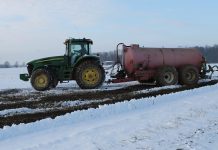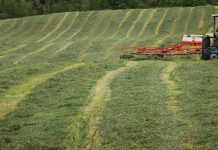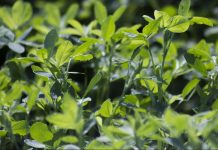For many, this time of year brings great joy as we are rejoined with the soil, the toil, and the Spray ‘n Wash in the hopes of growing something good. Whether it is green grass, fragrant flowers, or a variety of veggies, we dig our nails into the dirt while applying our best landscaping intentions — derived from wisdom of our ancestors or perhaps lessons learned from ghosts of gardens past.
Go green
This year, before jumping back into your usual lawn and garden practices, the soil and water conservation districts of Ohio urge you to do something different: Before reaching for that spade or sprayer, dare to try on something green.
Not literally, unless you look really good in green or are feeling some random Irish pride. By “trying on something green,” you are committing to make a change in your yard or garden while keeping soil and water at the forefront of your thoughts. You are mindful that:
— Soil and water are finite resources are vital to life on earth.
— Soil and water are not only capable of carrying pollutants, but capable of becoming polluted.
— That what you put on and do to your lawn, yard, and garden directly affects soil and water quality.
Do the math
Now for a math problem. If approximately 20 million U.S. acres are planted as residential lawns, and 67 million pounds of synthetic pesticides are used on U.S. lawns annually, what percentage of these pesticides make it into our streams, wells, and waterways?
I don’t know the answer, but just imagine whatever you’re applying to your lawn or garden is being sprayed into your glass of ice water or sprinkled onto your freshly sliced tomato.
Direct connections like these might sound extreme (and disgusting), but even more dangerous is our sense of disconnect. By trying on green yard and garden practices, we are staying connected to the roots of life — that everything we need also needs soil and water and we are accepting our responsibility to be stewards of these resources.
See for yourself
One great way to learn more about “green” lawn and garden practices is by attending The Gone Green Garden Tour June 5 from 1-5 p.m. Sponsored by Geauga Soil and Water Conservation District (SWCD), this unique drive-it-yourself tour consists of five stops showcasing gardening and environmentally friendly yard and garden practices. Visit www.geaugaswcd.com for more details.
But if Geauga gardens and greenscapes are beyond your road’s reach, fear not. We’ve compiled Seven Simple Steps to “Green” Yards and Gardens for you to try.
1. Build and Maintain Healthy Soil.
Know your soil type and test it for a clear understanding of how much nitrogen, phosphorus, and potassium it needs to grow healthy plants, along with the pH level. Over-applying nitrogen and phosphorus pollutes streams and waterways.
Whatever soil type you have, it can be improved by adding organic matter like compost, grass clippings, or mulch. Yard and food waste are gardeners’ gold because organic matter helps feed the soil, stabilize soil temperature, prevent weeds, and retain water and nutrients within the soil.
2. Plant Right for Your Site.
Evaluate your yard and consider available space for recreation, relaxation, gardening, and wildlife. Are there areas that are difficult for plants to grow and how much lawn do you want to maintain? Select plants that grow well in the amount of sun, soil type, and water available in your yard.
Consider growing a rain garden. These are designed to capture and filter runoff from homes, rooftops, and driveways. Not only do they enhance the beauty of your yard while creating habitat, but they filter storm water and alleviate flooding.
3. Go Native.
Native plants are better adapted to local conditions, attract birds, butterflies, and beneficial bugs, provide four season interest, and preserve native habitat. These “anchors” have roots that grow deep, creating channels that soak up rain water, hold soil together, and help prevent erosion.
4. Practice Smart Watering.
Most lawns are watered too often, but with too little water. It’s best to water only when the lawn really needs it and then to water slowly and deeply.
Why not save money by rolling out a rain barrel to collect and store rainwater from your rooftop? The water in these barrels can then be used for watering your landscape.
A little paint and imagination can turn a rain barrel into beautiful, functional, and “green” yard art. Check out Geauga SWCD’s annual Rain Barrel Yard Art Campaign at www.geaugaswcd.com.
5. Practice Natural Lawn Care: Mow high and let it dry.
Mowing high (keeping your lawn a bit long) will produce stronger, healthier grass with fewer pest problems. Mow more frequently during the active growing season so that you never cut more than one-third of the height of the grass.
A lawn’s ideal length will vary, but many grass species are healthiest when kept between 2.5-3.5 inches.
Leaving short grass clippings on the grass will recycle nitrogen back into the lawn and save the time and money it would take to bag the clippings.
Consider a lawn reduction by adding native groundcovers and specialty gardens.
6. Fertilize Sparingly and Caringly.
Why fertilize your lawn year after year if your soil does not need these nutrients? Getting your soil tested will save money and prevent harm to your lawn and pollution to waterways. If fertilizer is recommended, “natural organic” or “slow-release” fertilizers feed your plants slowly and evenly. Local resource experts can help you choose the right fertilizer, compost, and other soil amendments.
7. Don’t Bug Out.
One important thing to remember is to expect and accept a little damage, and give nature time to work. Even a healthy lawn will have some weeds and insect pests, but it will also have beneficial bugs (like the lady beetle and praying mantis) that bring balance by preying on pests.
Pesticides can be effective tools for controlling insect pests, but be sure to consider alternatives first. Because pesticides have risks and impacts, it is critical to use them properly and responsibly.













Great article Gail. Very informative and well presented. I hope this causes a few folks to contemplate their current “yard methods”, or even better……….implement some changes.
Keep up the good work!